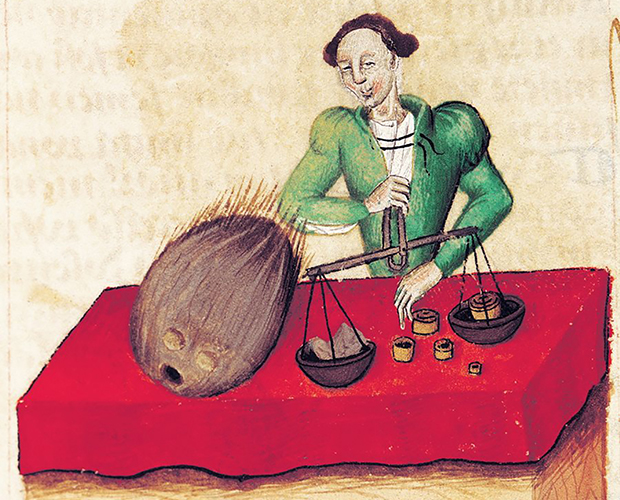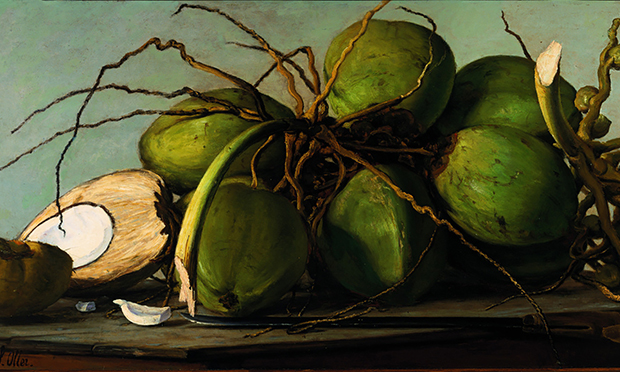Palm reading: Gillian Riley on coconuts

What do you do with an expensive and obdurate lump of neither wood nor stone, hard as nails, and encumbered with medicinal and gastronomic properties?
Team it up with a creature loaded with myth and symbolism, crafted by one of Antwerp’s finest silversmiths, and you get this numinous but somehow rather cheeky goblet.
This owl with attitude was made from a coconut into a drinking cup with a lid and ornate base by an unknown artist in 1548; both the silver-gilt head and the surface of the nut were engraved with ornate patterns, suggesting plumage and lace, and the head unscrewed to reveal a lacquered interior and round the rim an inscription in Old Dutch hinting at raucous nocturnal goings on.
The owl was an attribute of Minerva the goddess of wisdom, but it could also imply drunkenness and dissolute behaviour, the way it disgorges pellets is a not very subtle reminder of the effects of too much to drink.
Mixed messages here – a costly presentation goblet with a built-in health warning – and there were a lot of them about, of which at least thirty survive.
We don’t know who commissioned this one, or who made it, or how it got into the possession of an English archbishop in East Anglia, and then in and out of Sotheby’s, coming home to roost at last as the mascot of the King Baudouin Museum in its native city of Antwerp.
Antwerp in the sixteenth century was a rich trading city, with luxury goods flowing in and out, and coconuts were one of the exotic products bought and sold and appreciated for their medicinal and magical properties.
Cocos nucifera gets its name from the Spanish for head or grotesque face coco, or Portuguese cocuruto, skull, given it by Portuguese traders who were bringing coconuts to Europe by the end of the fifteenth century.

Here is a pharmacist of the time handling one, with its three blobs for eyes and mouth.
Coconuts have travelled the world from earliest times from their origins in two different places, Southern India and Sri Lanka and the Maldives, and South East Asian countries including Indonesia, the Philippines, Malaysia.
From these two far distant areas the plucky little nuts, bobbing along on their own on powerful ocean currents, settled happily on infertile sandy, salty, beaches, producing a benign and useful crop.
But even more fascinating is the story we find hidden in the coconut’s DNA; (we normally classify plants by their morphology, the way they produce and disperse their seeds, but DNA can tell us where they’ve been, and who they’ve been with).
Findings point to very early trade routes, with merchants, mariners and warriors taking coconuts with them as sustenance or trade goods, from Prehistoric times.
They kept company with people moving from both regions, east and west, and ended up in Africa via Madagascar, and South America from Mexico and the Caribbean.
Marco Polo saw them in the thirteenth century as he wandered along the Silk Route.
We call it a nut but the fruit of cocos nucifera is in fact a drupe, like the stone inside a cherry or a plum.

The outer layer is smooth and shiny, and often brightly coloured, like the skin of a plum, as you can see in this still life by the Caribbean’s only Impressionist painter, Francisco Oller.
Inside this outer layer is the ‘nut’ we see in the shops, with its hairy covering and the three dots that make the funny face, and inside that a hard shell, like the stone of a plum, enclosing a hollow kernel of solid flesh or ‘meat’ with a thin dark skin.
There is an Indonesian saying that there are as many uses of the coconut palm as there are days in the year, from matting, a rich oil for cooking and industrial use, to high explosives and baby skin (‘What’s the difference?’ mutters a weary Citizen parent).
Alan Davidson called it “the most useful tree in the world” and more prosaically it has been described as “the Swiss Army knife of the plant kingdom”.
Today in multi-racial Hackney we can get everything we need to enjoy the different cuisines which rely on coconuts for flavour and nutrition.
I can remember when all I had were packets of dried coconut, which had to be soaked in water and squeezed through a sieve to get the coconut milk or cream that we can now get in tins or cartons in most food stores.
This home brew had a light freshness and a more delicate flavour, so look carefully at the different varieties on offer, to avoid additives and stuff, and that over-cooked taste.
Unless you have the skills, buying a real live coconut and embarking on the cracking and grating risks much self-inflicted GBH and is best avoided.
A quick word on coconut water, which is the liquid you find in fresh coconuts, mildly sweet and refreshing when young, less so when older.
How this has become a nice little earner as a clean and healthy elixir with £1000 million turnover per annum, is a mystery.
The fact that wellness and fitness freaks feel that paying several quid for a bottle of this industrially produced drink – 94 per cent water with a few minerals and vitamins sloshing round in it, some calling themselves electrolytes, and with added sugar – can bring benefits that you don’t get from a mug of tap water and a banana, is beyond belief.
Paying pots of money brainwashes us into believing the hype (not science-based) that we can boost our athletic prowess whilst avoiding everything from cancer to high blood pressure. How innocent can you get?
Back in the kitchen, things are more, but sometimes less, healthy.
Coconut cream and milk are delicious additions to the flavour and texture of vegan food, and contain some useful minerals and vitamins, but the amount of saturated fat could be a problem, and there is not much protein on offer.
Combined with meat or fish, coconut is a versatile and imaginative ingredient, which we enjoy in the many cuisines of Hackney, and can buy them and their derivatives in food stores and markets.
Added at the last minute to an almost harsh and heavily spiced dish, a slug of coconut milk brings sweetness and light.
Used as the basic liquid in Indonesian beef rendang, well-spiced coconut milk evaporates in the long slow simmering to become a fragrant oil in which the now meltingly tender beef sizzles just a while before serving.
Our own Yum Yum’s cookbook has some lovely recipes using coconut.
